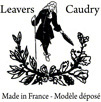What is a Leavers craft? It is a miracle, an unnatural association between the metal, the grease and the sound of the machine, and the refinement, finesse and delicacy of the lace.
Presentation
The monster of several tons of steel is handled by the Tullist, one of the many trades to intervene throughout the manufacturing process.
Three basic elements make it possible to create lace:
- the raw material is fed by the rollers (a): there can be up to 200 rolls on the same trade!
- the thread used for sewing comes from the reels (b), mounted on a carriage (c)
- the motif is read on pierced cards (d): the principle is a little the same as on a barbaric organ.
Rouleaux (a) sur métier / Rolls (a) on trade
Bobine (b) / Coil (c)
Chariot (c) / Trolley (c)
Ensemble chariot et bobine / Trolley and coil set
Carton (d) sur métier / Leavers craft cards (d)
Pre-production
Setting up a production is a long process (several weeks): the inertia linked to the sophistication of the system is a determining factor in the overall organization of work within a lace company.
The interview
The essential step that preserves the work tool. The Leavers businesses are the first to be concerned since their production is definitely stopped: their preservation depends on the future of the sector. A mechanic is responsible for the complete maintenance. Many other machines and elements also deserve the attention of the staff: the trolleys are regularly retouched and deburred, in addition to the pressing step that will be described below.
The preparation
The rolls, on which is put the raw material, are supplied internally: the operation is called OURDISSAGE and consists of winding the various son of raw material around a metal bar. The opportunity for us to pay tribute to the warrior who accomplishes a complex and delicate task, because simple in appearance but terribly complex: the different families of rollers and the diversity of materials used make each preparation unique ... and long!
Once the rollers ready, they are put back in the trade: this operation is called RANOUAGE and requires a lot of meticulousness because the wire of each roll must pass in a very precise hole and be connected to the wire which was in place.
Trolley and reel set
It is 'out' of the trade when the reel is almost empty (it provides the necessary thread for sewing). It is therefore necessary to dislodge it from its trolley (SEPARATION), empty it completely, reload it and put it back in its trolley (REASSEMBLY). Once reformed, this set is placed in the craft as and when being produced by the tulliste. SEPARATION and REASSEMBLY are performed either manually or by an AUTOMATE.
Reel path
1 : we present the coil still housed in his cart.
2 - SEPARATION: we dislodge it from its cart.
3 - EXTIRPAGE: the thread remaining in the spool is removed.
4 - WINDING: the winder gathers several reels to recharge them at the same time. He starts the threads manually and then starts winding.
5 - PRESSING and OVEN: The coils, now fully loaded, are placed in a press that goes into the oven. The purpose of the operation here is to preserve the long-term integrity of the coil and to catch the small deformations induced by the work on the trade.
6 - REASSEMBLY: replace the reels which are automatically put in their cart.
7 : the reel and trolley assembly is ready for use again
Trolley path
The trolley is placed on the automaton: the almost empty reel is removed, and a full one takes the place.
The cardboards
Following the creation of a drawing, the curves and arabesques are transcribed in the 'coding' of the Leavers trade. The DRILLING step is then performed.
Once drilled, the boxes are tied together and placed on the loom.
Production
All elements are installed: the tullist can launch the infernal machine. This stage will also not be a long calm river, the Tulliste having to be constantly attentive to the unfolding, because many traps mark the course: son who break, trade which flu etc.
At its exit, the piece is several meters wide by several tens of meters long.
Post-production
Finishing on fallen work piece
The fallen piece of craft is an undyed piece. At the output of production, the piece is checked by the repairer: the latter is in charge of stalking and repairing any small defects.
Dyeing - outsourced stage
Once the piece is checked, she leaves in dyeing.
Clipping - outsourced and optional step, as a function of the final product
Flaking
This is to remove the ends of the room.
Écaillage aux ciseaux / Shearing with scissors
Écaillage ciseaux électrique / Shearing with electric scissors
Mapping on a dyed part
Embroidery - optional step as a function of the final product
The embroiderer, over the lace, embroider patterns and additional materials to sublimate the realization.
Verification and conditioning
The piece is checked one last time and then specifically packaged and protected. But the work is far from over, the goal being that the magic that has occurred during all stages of production can continue to exert its charm through a Grand Couturier outfit, a wedding dress or a set of lingerie.







